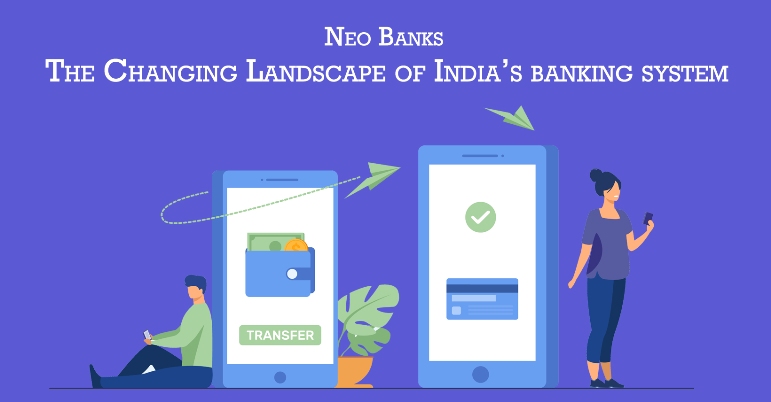With technological evolution, banks are changing at a breakneck pace. The rising usage of disruptive technologies has changed customer behaviors and expectations. Today’s customer wants convenience, transparency, affordable pricing, and exceptional service. To adapt to these changes, businesses and operating models are evolving likewise.

Today, a non-banking service provider has access to every area of the banking value chain thanks to its technological expertise and flexible and lean business structures. These models provide retail and small and medium business banking services primarily through the internet or other electronic means rather than through physical branches.
Neobanks are non-banking financial institutions. Compared to traditional banks, Neo banking provides more customer-centric and cost-effective services and experiences. Legacy systems, closely interwoven value chains, complicated administrative structures, and strict regulations confine traditional banks, but not neobanks. Neobanks do not have banking licenses in India, but they collaborate with bank-licensed service providers.
Micro and small businesses and unbanked or under banked clients such as freelancers and gig economy workers value the ease with which they may open and operate accounts, make seamless payments, and use transfer and remittance services. Therefore Neobanks target these customer segments. One of the target markets is Neo bank for teenagers in India, with rising popularity among teens. Neobanks have made formerly unavailable financial services or products with high costs available to these segments.
What is Neobank?
A Neobank is a digital bank that does not have any physical locations. It’s a broad category of financial service companies targeting today’s tech-savvy customers. Fintech organizations that provide digital and mobile-first financial solutions such as payments and money transfers, money loans, and more are known as neobanks.
Neobanks allow customers to access financial services at a lower cost. In addition, technology and artificial intelligence provide individualized services to clients while lowering operating expenses.
Neobanks have several qualities that have enabled them to carve out a place in the market:
Simple account opening:
Neobanks offer simpler online account opening and onboarding processes, alleviating a significant pain point for customers.
User-friendly interface: Some neobanks offer their customers a 360-degree perspective through unified dashboards that are simple to grasp and provide critical data such as incurred spending, owing bills, and bank statements.
Value-added services:
Neobanks offer various add-on services to their customers, such as budgeting, curated e-commerce, tax filing, and automated accounting.
Solid infrastructure:
Neobanks’ product and service offerings are safeguarded by reliable information technology and security infrastructure. Neobanks can provide bespoke services while maintaining a robust information security architecture and adhering to their bank partners’ data security standards.
Over the last two years, the Indian Neo banking environment has exploded.
With enhanced banking infrastructure and technologically advanced FinTechs, India’s financial services journey is transforming, with a greater focus on client needs. In addition, factors such as incumbent banks seeking strategic alliances with Neobanks and interest from private equity firms are contributing to India’s Neo banking growth narrative.
Neobanks are thriving by catering to end users’ fundamental needs, which include:
- Access
Access to financial services is still a top priority for retail and micro, small, and medium-sized company (MSME) clients. Neobanks have discovered hitherto untapped markets in tier-2 and rural areas and among digital millennials. Neobanks play a critical role in meeting their requirements because they are digitally literate and have recently expressed interest in financial products.
Traditional bank distribution mechanisms are restrictive and inefficient, with higher acquisition costs making specific customer segments unviable for conventional banks, perpetuating the overreliance on informal lending sources.
- Aligned financial products
Today’s customers demand products tailored to their unique needs in terms of quantity/ticket size, duration, and price. Such product developments necessitate dynamic technology and delivery solutions that allow start-ups to successfully manage unit economics while delivering a diversity of products in terms of quantity and pricing (for example, micro ticket-size loans/investments and short-term credit). Unfortunately, due to the rigid cost structures that traditional banking models operate under, they are frequently unable to offer flexible financial products.
- Convenience
Customers may now anticipate more excellent facilities across a wide range of service lines, from commerce and purchasing to logistics and travel, which has led to comparable expectations of convenience from financial services.
Some of the difficulties that neo-banks encounter include:
- Collaborations with established banks to meet regulatory obligations
- Determining the optimum product-market fit for target customer segments
- Acquiring new customers, creating awareness, and establishing trust are essential steps in customer acquisition.
Unfortunately, compared to traditional banks, Neobanks have less operational experience, so people trust them less.
Importance of Neobanks in today’s surroundings
Neo or digital-only banks use cutting-edge technology such as cloud computing, machine learning, and blockchain to expand the scope of the conventional banking system. Traditional banking gives access to various services such as deposit and credit assistance. Still, their activities appear to be limited to locations where a high cost-to-profit ratio is desirable, leaving unbanked areas with low cost-to-profit ratios.
The merger of traditional and technological models, such as neo-banks, opens up a sea of prospects, extending the reach of formal banking services to our country’s underserved or unserved people and re-igniting engines of growth that had slowed owing to the pandemic’s downturn.
With their ability to reach India’s outskirts and their evolving business models, Neo-banks hold enormous promise for a brighter and more sustainable future with their unique delivery methods. Moreover, these banks are ahead of the game when recommending/proposing well-curated offerings to their consumers.
Prospects of Neo banking in India
The driving elements for Neo banking expansion in India are accessibility, cost-effective multiple banking, and financial functions. Neo banks could be used to address financial inclusion issues. They can expand their scope of operations in the future by adding more functionality and services and targeting large customer bases. Even though neobanks are gaining traction, most are yet to achieve long-term profitability. Nonetheless, they are a disruptor in the banking and financial service sector.
Read Next Blog: Scope of IoT In Banking Sectors